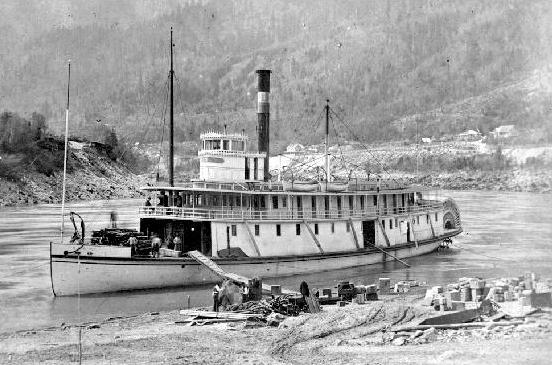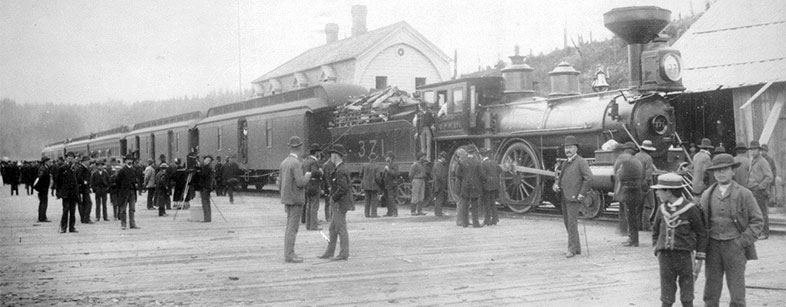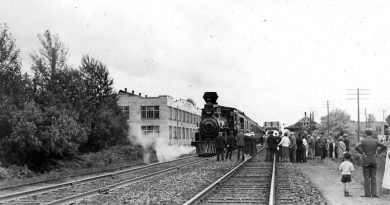British Columbia’s First Excursion Trip
From the Vancouver Daily Province, September 21, 1907
Mr. C.D. Rand Tells of Trip on First Railway Train West of the Rockies—-In the Days of the Port Moody Boom.
“Extraordinary thing about that ticket,” mused Mr. C.D. Rand, a pioneer who saw Vancouver cut out of the virgin forest, as he leaned back in his chair and gazed at a little red pasteboard minus one corner which he held in his hand. Mr. Rand had a minute before accidentally found the ticket among his office papers, and it carried him back over memory’s pathway through the crowded experiences of twenty-seven years, till it landed him on a seat in the first passenger train operated west of the Rockies on the Canadian Pacific Railway.
“That ticket,” he continued, giving expression to the reminiscent thoughts called up by the occasion, “reads to Emory by rail, but there is nothing about it to signify the starting point of the trip for which it was used. However, there are some notes in ink on the back of it which explain the whole matter. Read them.”
The cardboard was passed across the room, and this is the inky inscription, dulled by age but still plain, which it bore:
“This ticket was used by me on the first passenger train on the C. P. R. west of the Rocky Mountains. The train left Yale for Emory at 9 a.m.and returned at 1 p.m.—C. D. Rand”
On its face the ticket bore about as much resemblance to the present-day C. P. R. orders for transportation as an ancient papyrus roll does to a modern newspaper. To even the oldest conductor on the road that ticket would be a curiosity. It is probably the only receipt given by the C. P. R. for fifty cents’ worth of transportation on the first passenger train west of the Rockies which is in existence to-day.
Forty Hours’ Journey to Yale
“I remember very well that first trip of mine to Yale,” went on Mr. Rand, as he stowed the ticket away in a wallet containing a number of early-day souvenirs. “I was then living in New Westminster, and with others from there I took an excursion run up the river for the purpose of riding on that first train on the Pacific division of the then uncompleted first transcontinental railway of Canada. It was in July, 1881, and there was keen opposition among the boats running on the Fraser.

“The old stern-wheelers left New Westminster at seven o’clock in the morning for up-river points, and if they were fortunate arrived at Yale sometime in the forenoon of the next day—if they had bad luck they sometimes never reached Yale at all. Nowadays Yale is only three and a half hours’ run from Vancouver by rail, and travellers would roar complaint if they had to spend thirty or forty hours on the run, but in the old days we thought ourselves lucky not to have to walk.
“The steamers used to stop along the river wherever there was a passenger to be picked up or landed, or freight to be handled. Every few hours the nose of the old boat I travelled in would be pushed into the mud of the banks opposite a woodpile, and the passengers would be invited to participate in the carrying of cordwood up the gangplank—it was great exercise, and incidentally saved the owners of the boat the wages of half a dozen deckhands.”
Old-time Rivalry of River Steamers
“The boat I travelled on that trip was the Cassiar, and Harry Bishop, now wharf agent of the C. P. R. at Victoria was purser. Harry was the best dressed man on the river in those days, and the most obliging and best liked purser on the run. Another boat, the name of which I have forgotten, was racing upstream with us. We both had a fair start from New Westminster, and it was a close seesaw all the way up the river; when we would stop, our rival would pass ahead; but sooner or later we would crawl up and pass her as she lay at some woodpile taking on fuel.
“The rivalry between the captains of the boats was so keen that there were some strenuous races, as the holes made in the woodpiles showed, but fir was cheaper then than now and passenger traffic more in demand. As we ascended the river the water became much swifter. The boilers of the boats were limited to a pressure of one hundred pounds of steam, but when riffles were reached the little needle on the steam gauge somehow always managed to crawl up the scale till it registered a hundred and thirty-five or a hundred and forty-five pounds.
“On such occasions a suggestion was generally made from the pilot house that the passengers had better get out on the bow of the boat, as with the weight well forward it would be easier to steer. Whether this was a fact, or whether in the event of the boilers going through the upper deck on a hurry call the passengers would be safer out of their path, is hard to say; I always suspected, however, that the captain always wished to give us a chance for our lives in the event of an explosion.
“At three or four points where the river was very swift, it was necessary to run cables to trees ashore, or to rocks on the bank, and warp the steamer over the riffles. On these occasions the passengers were never omitted when invitations to lend a hand at the windlass were passed around verbally.
“The first day’s run took us to somewhere near Hope, where both boats tied up on account of darkness. We started again at dawn, reaching Yale some time during the forenoon.
“Yale was the head of navigation; and from there started the old Cariboo road, which was built in 1863-64 to the then famous placer mines of the Cariboo district. During the days of the gold rush, Yale was the outfitting point of the miners. In 1881 it was headquarters for the gangs of men engaged on railway construction. That portion of the line between Emory Bar and Savona was then being built by Andrew Onderdonk, who held his contract from the Canadian Government.
“Yale was the liveliest town in British Columbia during construction.
“It was the centre of all the upcountry business as well as the railway work, and the headquarters for all the gamblers and deadbeats in the country.”
First Passenger Train in British Columbia
“The first passenger train was advertised to run on July 4—the citizens of British Columbia then celebrating the Fourth more generally and more strenuously than they did the First of July. So far as my memory serves me, the train consisted of an engine, tender and four flat cars, the latter equipped with the hardest kind of wooden seats in order that the passengers might thoroughly appreciate the fact that the roadbed was new.
“The train started from Yale, went east through tunnels Nos. 1 and 2, which had just been completed, passing through Yale and going down as far as Emory, which was about five or six miles below Yale.

[Photo: City of Port Moody]
“On the way down the conductor of the train—not having a conductor’s punch—tore off the corners of the tickets. He intended to take up the tickets on the return trip. I was saving souvenirs at the time and was anxious to keep my ticket, so when asked for it by the conductor I gave no sign that I noticed him. Some friends with me volubly explained that I was deaf and dumb, and the conductor, after going through considerable pantomime in which I earnestly joined, left me in disgust and I succeeded in carrying off the ticket in triumph. It is probably the only one in existence to-day, and I propose to keep it as a family heirloom.
“By the way,” continued Mr. Rand, warming up as the pioneer scenes were recalled, “I not only rode on the first passenger train west of the Rockies, but I claim to have driven the first spike in the Canadian Pacific Railway at tidewater at Port Moody. I happened to be in Port Moody one afternoon on business, and while there Mr. A. J. Hill who was engineer in charge of construction at that point, told me that rail-laying would start on the following morning, and he invited me to spend the night with him at his home. He was then living on the wharf at Port Moody, which has long since been eaten by teredos [a kind of clam; they don’t actually eat the wood, but burrow into it]. I told Mr. Hill that if he would allow me to drive the first spike I would stay over and attend the ceremonies. He agreed.
“The following morning I arose about five o’clock. When the first rail had been placed in position I with all due ceremony, and in the presence of the track-laying gang, the engineering staff and two small boys, drove the first spike ever planted deep into the timber at salt water on the Canadian Pacific.”
When Port Moody Was Booming
“Yes, it is true that Port Moody was then in the throes of a real estate boom. A great deal has been said about this boom and the immense sums of money which were lost there, but the great losses are largely a fable. A certain amount of money was lost, it is true, but no person was seriously injured financially.
“The boom lasted about six months, and lots at the start sold at from $50 to $75 each. I distinctly remember one transaction, in which I sold a capitalist seventy-five lots for $5000. These lots were all sixty-six feet in frontage and one-hundred and thirty-two feet in depth, and were all business property—real estate men will appreciate this point. The transaction took place during the latter part of June, and before the end of the following October—or within four months from the time of purchase—the lots had been resold at an average price of $1000 per lot.
“The boom was short lived, and reached its height on a Saturday afternoon. On the following Monday morning lots were unsaleable, word having been received that the C. P. R. had altered its mind about Port Moody as a terminus and intended to push farther down on Burrard Inlet and take up a position on the ground now occupied by the city of Vancouver. Of course, some doubt was expressed about this news at first, but it proved too true, and then there was a scramble for Gastown.
“No, no; I will not go into details just now about that Port Moody boom; but it is a good story, as some residents of Vancouver are well aware, and will make interesting reading when I find time to tell it.”


!["Off For Sechelt" [S.S. "Sechelt"]](https://vancouverhistory.ca/wp-content/uploads/2009/12/301eedda-8cbb-4506-aee5-9d4f17f403d8-A24242-390x205.jpg)